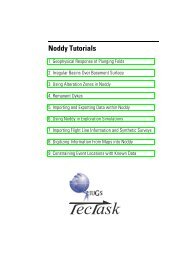Revised Eburnean geodynamic evolution of the ... - Tectonique.net
Revised Eburnean geodynamic evolution of the ... - Tectonique.net
Revised Eburnean geodynamic evolution of the ... - Tectonique.net
You also want an ePaper? Increase the reach of your titles
YUMPU automatically turns print PDFs into web optimized ePapers that Google loves.
30 S. Perrouty et al. / Precambrian Research 204– 205 (2012) 12– 39<br />
Fig. 11. Interpreted photographs showing examples <strong>of</strong> D3 deformation. (A) In <strong>the</strong> Sefwi Group, <strong>the</strong> S1 foliation defined by <strong>the</strong> alignment <strong>of</strong> biotite are partially transposed<br />
along <strong>the</strong> S3 cleavage. (B) Series <strong>of</strong> F3 ptygmatic folds at <strong>the</strong> same location. These F3 are folding a composite S0/S1 foliation and some quartz veins. (C) On <strong>the</strong> western side<br />
<strong>of</strong> <strong>the</strong> belt, F3 folds correspond to <strong>the</strong> first folding generation affecting <strong>the</strong> Kumasi Group sediments. (D) Parasitic open folds in <strong>the</strong> hinge <strong>of</strong> <strong>the</strong> Damang anticline in <strong>the</strong><br />
Tarkwa Group. In all cases, S3 corresponds to a subvertical crenulation cleavage resulting from a NW-SE shortening. The compass indicates both <strong>the</strong> north (in red) and <strong>the</strong><br />
perspective. (For interpretation <strong>of</strong> <strong>the</strong> references to colour in this figure legend, <strong>the</strong> reader is referred to <strong>the</strong> web version <strong>of</strong> this article.)




